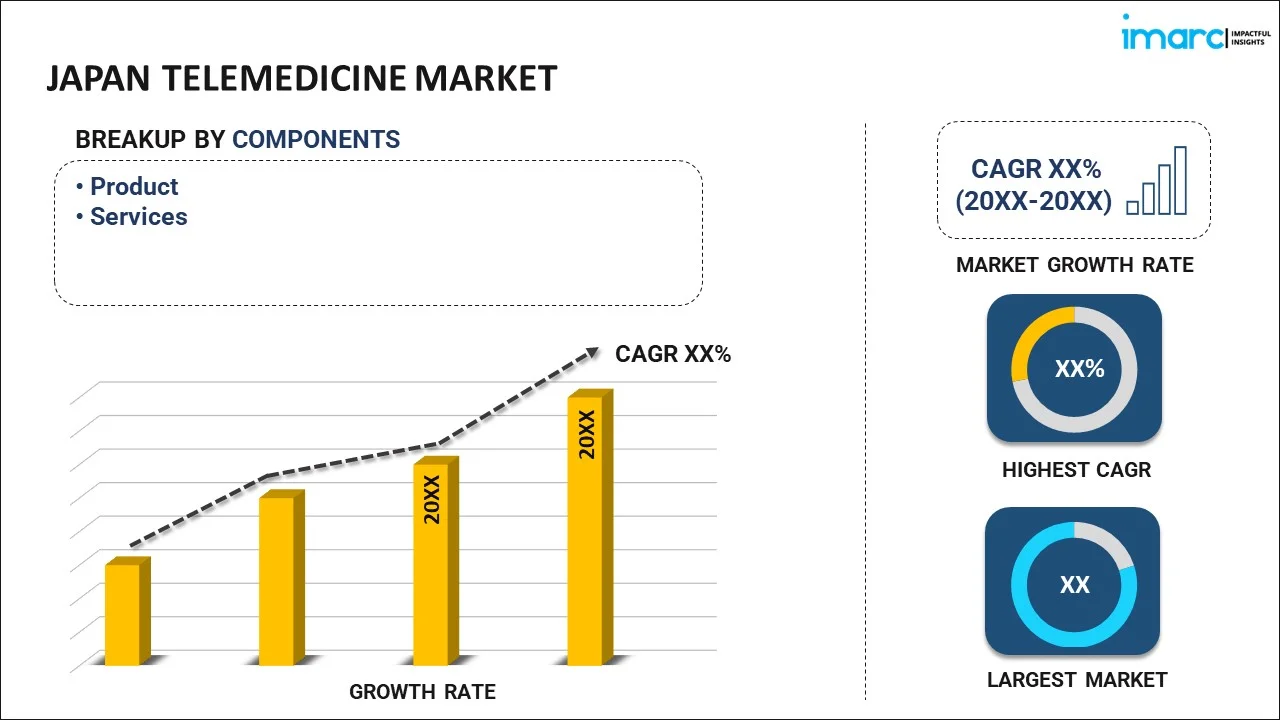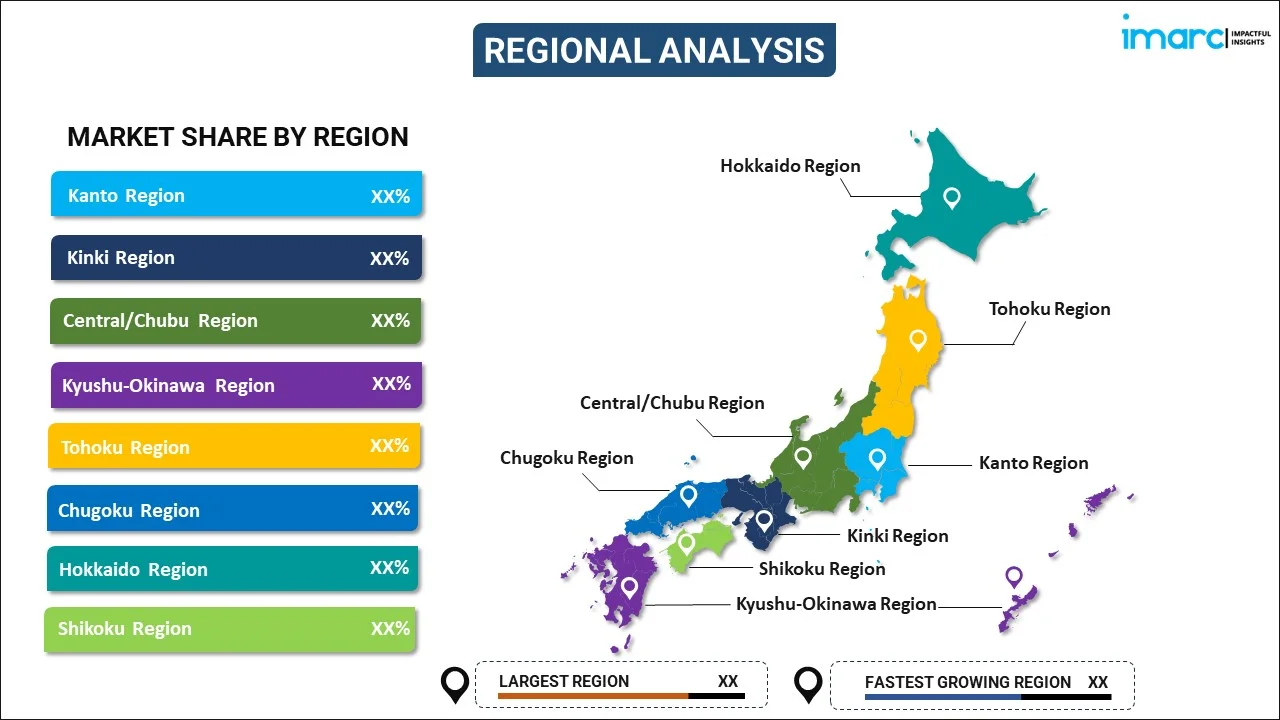
Japan Telemedicine Market Report by Component (Product, Services), Modality (Real-Time, Store and Forward, and Others), Delivery Mode (Web/Mobile, Call Centers), Facility (Tele-hospital, Tele-home), Application (Teledermatology, Teleradiology, Telepsychiatry, Telepathology, Telecardiology, and Others), End User (Providers, Payers, Patients, and Others), and Region 2025-2033
Market Overview:
The Japan telemedicine market size reached USD 5.2 Billion in 2024. Looking forward, IMARC Group expects the market to reach USD 20 Billion by 2033, exhibiting a growth rate (CAGR) of 16.2% during 2025-2033. The rising geriatric population prone to chronic illnesses, rapid technological advancements, growing urbanization, proliferation of smartphones, increasing demand for digital solutions for managing their health and accessing medical care, lifestyle changes, and the implementation of various government initiatives represent some of the key factors driving the market.
|
Report Attribute
|
Key Statistics
|
|---|---|
|
Base Year
|
2024 |
|
Forecast Years
|
2025-2033
|
|
Historical Years
|
2019-2024
|
| Market Size in 2024 | USD 5.2 Billion |
| Market Forecast in 2033 | USD 20 Billion |
| Market Growth Rate (2025-2033) | 16.2% |
Telemedicine, also known as telehealth, refers to the remote provision of healthcare services and medical consultations using telecommunications technology. It encompasses a broad range of services, tools, and technologies that enable healthcare providers to diagnose, treat, monitor, and manage patients without the need for in-person visits. Telemedicine encompasses various forms of communication, such as video calls, phone calls, secure messaging, and data sharing, to facilitate medical consultations and the exchange of medical information. Moreover, it facilitates ongoing care management and follow-up, ensuring continuity of care for chronic conditions and post-surgical recovery. Telemedicine offers enhanced accessibility, convenience, and patient engagement while also providing opportunities for healthcare providers to optimize medical practice and improve outcomes.
Japan Telemedicine Market Trends/Drivers:
The rising geriatric population is one of the key factors driving the market growth in the country. Telemedicine is widely used to remotely monitor conditions such as diabetes, hypertension, heart disease, and arthritis by tracking vital signs, medication adherence, and symptom progression. Besides this, the growth and development of cutting-edge technology in the country, such as high-speed internet connections and innovative medical devices, facilitate remote consultations and monitoring, is acting as another growth-inducing factor. Moreover, the implementation of various initiatives by the Japanese government to encourage the adoption of digital health solutions is favoring the market growth. Furthermore, various financial incentives, streamlined licensing procedures, and other measures to promote the adoption of telemedicine services are further propelling the market growth. Apart from this, the increasing adoption of telemedicine during the COVID-19 pandemic as a means to provide healthcare services to the masses while minimizing the risk of infection is providing a considerable boost to the market growth. Additionally, the widespread adoption of telehealth, owing to its convenience and cost-effectiveness of receiving medical care from the comfort of homes or workplaces, and reducing the need for travel and waiting times, is contributing to the market growth. Besides this, the integration of telemedicine platforms with electronic health records (EHR) to enhance the continuity of care, enabling healthcare providers to have access to patient histories and medical information during remote consultations, is positively influencing the market growth. Other factors, including an enhanced focus on research and development (R&D), increasing demand for personalized healthcare delivery, rowing emphasis on wellness and preventive healthcare, and rapid urbanization, are providing remunerative growth opportunities for the market.
Japan Telemedicine Industry Segmentation:
IMARC Group provides an analysis of the key trends in each segment of the Japan telemedicine market report, along with forecasts at the country levels for 2025-2033. Our report has categorized the market based on component, modality, delivery mode, facility, application, and end-user.
Breakup by Component:

- Product
- Hardware
- Software
- Others
- Services
- Tele-consulting
- Tele-monitoring
- Tele-education
The report has provided a detailed breakup and analysis of the market based on the component. This includes product (hardware, software and others), and services (tele-consulting, tele-monitoring and tele-education).
Breakup by Modality:
- Real-time
- Store and Forward
- Others
A detailed breakup and analysis of the market based on the modality has also been provided in the report. This includes real-time, store and forward, and others.
Breakup by Delivery Mode:
- Web/Mobile
- Audio/Text-based
- Visualized
- Call Centers
A detailed breakup and analysis of the market based on the delivery mode has also been provided in the report. This includes web/mobile (audio/text-based and visualized) and call centers.
Breakup by Facility:
- Tele-hospital
- Tele-home
A detailed breakup and analysis of the market based on the facility has also been provided in the report. This includes tele-hospital and tele-home.
Breakup by Application:
- Teledermatology
- Teleradiology
- Telepsychiatry
- Telepathology
- Telecardiology
- Others
A detailed breakup and analysis of the market based on the application has also been provided in the report. This includes teledermatology, teleradiology, telepsychiatry, telepathology, telecardiology, and others.
Breakup by End User:
- Providers
- Payers
- Patients
- Others
A detailed breakup and analysis of the market based on the end user has also been provided in the report. This includes providers, payers, patients, and others.
Breakup by Region:

- Kanto Region
- Kinki Region
- Central/Chubu Region
- Kyushu-Okinawa Region
- Tohoku Region
- Chugoku Region
- Hokkaido Region
- Shikoku Region
The report has also provided a comprehensive analysis of all the major regional markets, which include Kanto Region, Kinki Region, Central/Chubu Region, Kyushu-Okinawa Region, Tohoku Region, Chugoku Region, Hokkaido Region, and Shikoku Region.
Competitive Landscape:
The report has also provided a comprehensive analysis of the competitive landscape in the market. Competitive analysis such as market structure, key player positioning, top winning strategies, competitive dashboard, and company evaluation quadrant has been covered in the report. Also, detailed profiles of all major companies have been provided.
Japan Telemedicine Market Report Coverage:
| Report Features | Details |
|---|---|
| Base Year of the Analysis | 2024 |
| Historical Period | 2019-2024 |
| Forecast Period | 2025-2033 |
| Units | Billion USD |
| Scope of the Report | Exploration of Historical and Forecast Trends, Industry Catalysts and Challenges, Segment-Wise Historical and Predictive Market Assessment:
|
| Components Covered |
|
| Modalities Covered | Real-Time, Store and Forward, Others |
| Delivery Modes Covered |
|
| Facilities Covered | Tele-hospital, Tele-home |
| Applications Covered | Teledermatology, Teleradiology, Telepsychiatry, Telepathology, Telecardiology, Others |
| End Users Covered | Providers, Payers, Patients, Others |
| Regions Covered | Kanto Region, Kinki Region, Central/Chubu Region, Kyushu-Okinawa Region, Tohoku Region, Chugoku Region, Hokkaido Region, Shikoku Region |
| Customization Scope | 10% Free Customization |
| Post-Sale Analyst Support | 10-12 Weeks |
| Delivery Format | PDF and Excel through Email (We can also provide the editable version of the report in PPT/Word format on special request) |
Key Questions Answered in This Report:
- How has the Japan telemedicine market performed so far and how will it perform in the coming years?
- What has been the impact of COVID-19 on the Japan telemedicine market?
- What is the breakup of the Japan telemedicine market on the basis of component?
- What is the breakup of the Japan telemedicine market on the basis of modality?
- What is the breakup of the Japan telemedicine market on the basis of delivery mode?
- What is the breakup of the Japan telemedicine market on the basis of facility?
- What is the breakup of the Japan telemedicine market on the basis of application?
- What is the breakup of the Japan telemedicine market on the basis of end user?
- What are the various stages in the value chain of the Japan telemedicine market?
- What are the key driving factors and challenges in the Japan telemedicine market?
- What is the structure of the Japan telemedicine market and who are the key players?
- What is the degree of competition in the Japan telemedicine market?
Key Benefits for Stakeholders:
- IMARC’s report offers a comprehensive quantitative analysis of various market segments, historical and current market trends, market forecasts, and dynamics of the Japan telemedicine market from 2019-2033.
- The research study provides the latest information on the market drivers, challenges, and opportunities in the Japan telemedicine market.
- Porter's five forces analysis assist stakeholders in assessing the impact of new entrants, competitive rivalry, supplier power, buyer power, and the threat of substitution. It helps stakeholders to analyze the level of competition within the Japan telemedicine industry and its attractiveness.
- Competitive landscape allows stakeholders to understand their competitive environment and provides an insight into the current positions of key players in the market.
Need more help?
- Speak to our experienced analysts for insights on the current market scenarios.
- Include additional segments and countries to customize the report as per your requirement.
- Gain an unparalleled competitive advantage in your domain by understanding how to utilize the report and positively impacting your operations and revenue.
- For further assistance, please connect with our analysts.
 Request Customization
Request Customization
 Speak to an Analyst
Speak to an Analyst
 Request Brochure
Request Brochure
 Inquire Before Buying
Inquire Before Buying




.webp)




.webp)












